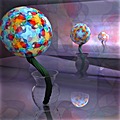- By Linda Glaser
- Entertainment
 Print
Print  Twenty-five stunning visual images go on display in Cornell's Malott Hall on Sept. 12, in "SymmetryScapes: An Exhibition of Mathematical Art." Artist Frank Farris created the display's aluminum prints, purchased by Cornell's math department, to celebrate the beauty and diversity of symmetry. The exhibit runs until Dec. 12, when it will move temporarily to the Sciencenter in Ithaca. Viewing hours are Mon.-Thurs. 8 am to 8 pm, Fri. 8 am to 4 pm, and Sun. 1-5 pm, on the fourth floor of Malott Hall. Admission is free and the public is welcome.
Twenty-five stunning visual images go on display in Cornell's Malott Hall on Sept. 12, in "SymmetryScapes: An Exhibition of Mathematical Art." Artist Frank Farris created the display's aluminum prints, purchased by Cornell's math department, to celebrate the beauty and diversity of symmetry. The exhibit runs until Dec. 12, when it will move temporarily to the Sciencenter in Ithaca. Viewing hours are Mon.-Thurs. 8 am to 8 pm, Fri. 8 am to 4 pm, and Sun. 1-5 pm, on the fourth floor of Malott Hall. Admission is free and the public is welcome.Farris, a mathematician at Santa Clara University, points out that symmetry seems to be a universal human experience: every known decorative culture produces some version of repeat patterns. "We all seem to take delight in seeing that one part of a pattern exactly matches another. Symmetry connects to the rhythms of our bodies and the cycles of the seasons, making it a sort of comfort food for our eyes."
To create his art, Farris begins with mathematical formulas that encode a certain type of symmetry pattern on a plane. He then uses a photograph that supplies the colors that are transported to the plane based on the mathematical formulas. In the end the formulas are invisible, but the colors reveal the symmetry pattern to the viewer.
Exhibit visitors will have their own hands-on chance to experiment with symmetry. Transparencies with copies of the images on display will be provided, and visitors can manipulate the transparencies over paper copies of the images, giving the visitor a kinetic feeling for the symmetries.
"Symmetry is intuitive but it's also something that can be understood on many levels, both visual and kinetic," explains Robert Strichartz, professor of mathematics in the College of Arts and Sciences and organizer of the exhibit.
Strichartz realized the appeal of Farris' work when he brought home the artist's book, "Creating Symmetry." "My grandkids saw it and were awed by the art," says Strichartz. "They're 13 and 10, so I thought Farris' work was something that would have a wide appeal and would be a great thing to bring to Cornell. I'm always interested in outreach that shows the fun in mathematics."
The exhibit includes two interpretive texts for each artwork, one explaining the concept of the image and one, labeled "Technical Talk," that explains the underlying mathematics in an accessible manner.
Farris will visit Cornell on Sept. 29 to deliver the Kieval Lecture, at 4:30 pm in Bache Auditorium, Malott Hall, on the mathematics of symmetry and his techniques. This will be a talk aimed at the level of undergraduate math majors.
v12i34



